Ijraset Journal For Research in Applied Science and Engineering Technology
- Home / Ijraset
- On This Page
- Abstract
- Introduction
- Conclusion
- References
- Copyright
Discerning Deception: A Face-Centric Deepfake Detection Approach with ResNeXt-50 and LSTMs
Authors: Aman Kumar Emaley
DOI Link: https://doi.org/10.22214/ijraset.2024.61186
Certificate: View Certificate
Abstract
.I. has grown to epidemic proportions over the last years as its applied in almost all sectors to allocate workload from humans but end up being done effectively with no human intervention. A branch of A.I. called deep learning, which operates by mimicking human judgment and action through neural network systems. Nonetheless, with the increase height of the two platforms have been experienced sufficient cases of misguided individuals using tools to recycle videos, audios, and texts to achieve their agendas. This insinuates a due assumption that Generative Adversarial Networks, GANs, are central to the development of believable deepfakes. GANs have developed a crucial ability to generate videos that replace frames with material from another video source to create deepfakes videos. While GANs serves various purposes such as entertainment, teaching, and experimentation, malicious actors can misuse these deep learning techniques to manipulate videos, impacting the privacy of individuals in society. This paper conducts an analysis of different deepfake detection models, comparing their efficacy and discussing potential future extensions of deepfake technology. The study presents a novel deepfake detection approach utilizing a combination of Convolutional Neural Networks (CNN) and Recurrent Neural Networks (RNN). This method utilizes ResNext50 for extracting features at the frame level, while employing LSTM (Long Short-Term Memory) for video classification based on these extracted features. Various datasets are incorporated, including the deepfake detection challenge dataset (DFDC) and Face Forensics deepfake collections (FF++), combining them to achieve a high-accuracy model capable of accurately discerning between real and deepfake videos. The results of this study make a valuable contribution to the continuous endeavors aimed at improving deepfake detection abilities and ensuring privacy protection in a time heavily influenced by artificial intelligence.
Introduction
I. INTRODUCTION
In today's world, where smart devices are ever-present and social media is extensively used to capture and share moments from daily life, the rise of advanced AI technologies brings significant concerns about media manipulation. Despite these concerns, AI offers numerous advantages, boosting productivity and capacity without tiring. AI finds applications across many fields, including entertainment, education, and forecasting future events such as stock market trends, weather changes, and health conditions in both people and plants. AI's integration into social media platforms enhances user experiences, while online third-party AI tools use the technology for manipulative purposes, creating fake news and misleading information through modified videos, audio, and text. Documented instances exist of AI producing deepfake videos and fake voices, spreading content fueled by conspiracy theories and privacy invasions. Academic research has shown cases where AI alters the voices of famous celebrities for entertaining memes on social media platforms. Moreover, companies use AI to create deepfake videos of celebrities endorsing products, which not only poses privacy risks but also spreads misinformation. Given the increasing capabilities of AI, it's essential to develop methods to detect and prevent media manipulation, thereby safeguarding privacy and fighting the spread of false information. The global issue of deepfake manipulation allows malicious actors to distort videos or audio for personal gain, leading to the extensive distribution of such content online. This invasion of individuals' personal lives can significantly damage the reputations of celebrities and other public figures.
A. Related Work
Researchers are actively studying various techniques to detect deepfakes using deep learning architectures. One common approach focuses on facial data, as deepfake methods typically introduce unique artifacts and inconsistencies in facial regions. By concentrating on facial features, these methods aim to identify the signs of manipulation. Researchers are employing various deep learning methods for this purpose, including CNN-based, RNN-based, and other specialized architectures like ResNext50 or LSTM, particularly focusing on facial datasets.
CNN-based Methods: Convolutional Neural Networks (CNNs) are effective for detecting deepfakes due to their strengths in image analysis and feature extraction. For example, Dang et al. (2020) utilized CNN architectures to detect inconsistencies and alterations in facial features, demonstrating their approach's effectiveness in differentiating between deepfakes and real media [3].
RNN-based Methods: Recurrent Neural Networks (RNNs) able to effectively identify patterns over time and anomalies within video sequences, making them suitable for deepfake detection tasks. Li et al. (2019) contributed to this area with their paper "Detecting Face-Swapped Videos Using Recurrent Neural Networks," employing RNN techniques to analyze temporal patterns in facial alterations, highlighting their utility in identifying deepfake videos [4].
Specific Architectures on Face-Only Datasets: Researchers have also explored specialized architectures like ResNext50 and LSTM for deepfake detection on facial datasets. Dolhansky et al. (2020) used the ResNext50 architecture on facial data in their work "Deepfake Detection Using Convolutional Neural Networks and ResNext50," showcasing the approach's potential in identifying manipulated facial content [5]. Similarly, Truong et al. (2021) applied LSTM networks on facial datasets in their study "Deepfake Detection Using LSTM on Face-Only Data," demonstrating the technique's effectiveness in distinguishing deepfake videos [6].
B. Methodology
In our endeavor to achieve deep feature visualization for enhanced deepfake detection using face-only data, we embark on a comprehensive approach that harnesses the power of multiple datasets and cutting-edge deep learning techniques. Our journey begins with the amalgamation of three renowned datasets: FF++, Celeb-DF, and DFDC. By harmonizing these datasets, we extract crucial labels that serve as the ground truth, providing invaluable insights into the authenticity of each video. However, our focus extends beyond mere label extraction. We recognize the significance of transforming these videos into face-only representations, a critical step that aligns with our deep feature visualization approach. By isolating the facial regions, we can concentrate our analysis on the intricate details and nuances that often hold the key to distinguishing genuine content from manipulated deepfakes.
Central to our methodology is the employment of Generative Adversarial Networks (GANs), a powerful technique of deep learning that has revolutionized the field of image synthesis and manipulation. We begin by segmenting the videos into individual frames, allowing for a granular examination of each moment. Subsequently, we substitute the input images for each frame, a process that serves as a precursor to the comprehensive reconstruction of the entire video. This reconstruction phase may involve the utilization of autoencoders, ensuring a nuanced understanding of the video's compositional elements. Inspired by a novel deep learning-based approach detailed in existing literature, we capitalize on the identifiable traits inherent to deepfake content. Notably, we synthesize face images of fixed dimensions, a process that often yields discernible artifacts stemming from affine warping. These artifacts serve as critical indicators, guiding our detection approach and enhancing its accuracy.At the core of our approach lies the strategic fusion of two powerful deep learning architectures: a ResNext Convolutional Neural Network (CNN) and a Recurrent Neural Network (RNN) with Long Short-Term Memory (LSTM). This union harnesses the strengths of both architectures, enabling us to effectively capture the temporal inconsistencies introduced by GANs during the reconstruction process. The ResNext50 CNN model, in particular, undergoes rigorous training to directly simulate resolution inconsistencies within affine face wrappings, further refining its ability to detect subtle anomalies.
C. Objectives
- Face-Only Representation: Transform videos into face-only representations to concentrate analysis on facial details vital for deepfake detection.
- Feature Extraction with ResNext50: Employ ResNext50, a powerful Convolutional Neural Network (CNN), for feature extraction at the frame level, focusing specifically on facial regions in face-only data.
- Design and implement a user-friendly, robust deepfake detection tool specifically tailored to analyses facial regions in videos, identify and flag manipulated content within face-only data.
II. PROPOSED METHOD
A. Data Acquisition and Preprocessing for Real-Time Efficiency
Achieving a real-time deepfake detection necessitates a careful balance between accuracy and computational efficiency. Our approach addresses these aspects through a meticulously designed data acquisition and preprocessing strategy.
- Dataset Selection and Augmentation
To enhance the model's exposure to diverse deepfake techniques and improve generalizability, we leverage multiple datasets:
- Face Forensics++ (ff++): This extensive dataset encompasses a variety of deepfakes created using different techniques, providing a solid base for training models.
- Deepfake Detection Challenge (DFDC): This large-scale dataset includes both authentic and fake videos, though it may feature audio-manipulated content. Since our research is centered on visual deepfakes, we handle this by eliminating audio elements.
- Celeb-DF: This dataset focuses on deepfakes involving celebrity and YouTuber faces, adding further variety to our training materials.
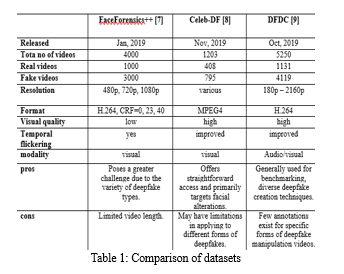
Our model undergoes training with a wide variety of datasets, which include numerous methods of deepfake generation and various authentic situations. This exposure broadens the model’s adaptability across different contexts. In addition, we enhance the dataset by integrating data augmentation strategies like arbitrary cropping, horizontal flips, and variations in color tones. Such methods serve to expand the training dataset’s volume and variety, all while negating the need for gathering more video data.
2. Preprocessing: Focusing on Faces and Frame Selection
To optimize our model for real-time processing on resource-constrained environments, we implement a targeted preprocessing pipeline:
- Video Splitting and Face Detection: We begin by splitting each video into individual frames. Then, a robust face detection algorithm locates facial regions within each frame, allowing us to focus solely on the most informative areas for deepfake detection and reducing computational overhead compared to processing entire video frames.
- Frame Cropping and Thresholding: The frames containing detected faces are cropped, retaining only the relevant facial information. To maintain consistency in the model's input and reduce processing requirements, we establish a threshold value (p) based on the average frame count across the dataset using the formula:

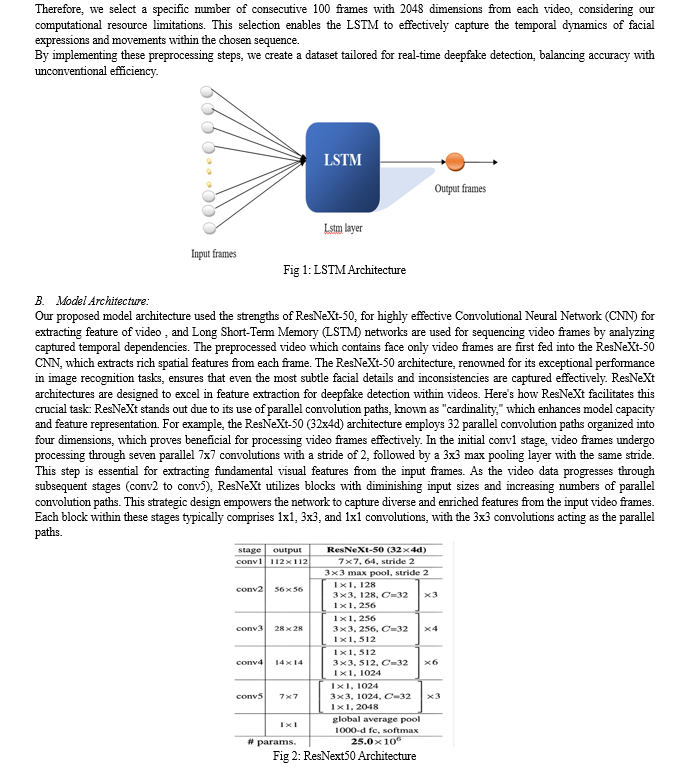

The LSTM component processes the sequence of features extracted by ResNeXt-50, capturing the temporal dependencies and irregularities that may be introduced by deepfake manipulation techniques. By leveraging the strengths of both ResNeXt-50 and LSTMs, our model can effectively analyze the spatial and temporal aspects of the video data, enabling accurate and robust deepfake detection.
C. Training the Model for Optimal Performance:
Utilizing Pre-trained Models: In our strategy, we employ a pre-trained ResNeXt-50 model to extract features, benefiting from the model's substantial training on extensive image datasets like ImageNet. This model acts as the base of our architecture, providing robust learned visual features. By fine-tuning the final layers of ResNeXt-50, we specialize its feature extraction capabilities for deepfake detection, thereby tailoring the model to better recognize manipulated videos.
Hyperparameter Optimization: To improve the model's performance and optimize the training process, we engage in hyperparameter tuning. This involves adjusting key parameters such as the learning rate (set at 1×10-5 ), optimizer choice (using Adam with a weight decay of 1×10-5 ), and dropout rate to achieve the best performance on a validation set. We employ strategies like grid search or random search to explore various hyperparameter combinations and find the configuration that delivers the best outcomes for our model. This approach allows us to fine-tune the model for exceptional performance in deepfake detection and ensures it generalizes effectively to new data.
- Loss Function and Optimizer Selection:
When training a model to classify data as either real or deepfake, aim is to make the trained model's outcomes as close as possible to the actual labels (real or deepfake) of the training data. To measure how far off the model's predictions are from the actual labels, we use a mathematical tool called the binary cross-entropy loss function. This function helps us see how much the model's predictions differ from the actual data, and it penalizes the model when it makes incorrect predictions.
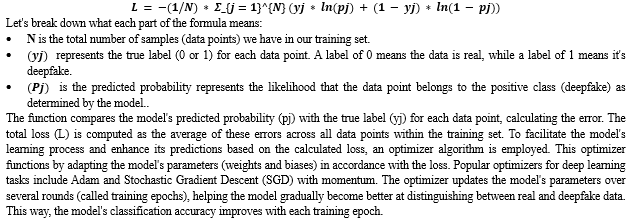
D. Training and Validation Split
To effectively train the deepfake detection model, we divide the preprocess dataset into two subsets: a training set and a test set, also referred to as a validation set. The training set comprises roughly 80% of the data, total 3,828 samples in this instance. Its purpose is to train the model in distinguishing deepfakes. The remaining 20%, or 958 samples, constitute the test set, which plays a crucial role in evaluating the model's performance and its ability to generalize to unseen data. The training set is evenly balanced, consisting of 1,986 real samples and 1,842 fake samples providing a diverse mix for the model to learn from. Similarly, the test set includes 495 real samples and 463 fake samples, serving as a benchmark for assessing the model's performance on data it hasn't encountered during training. Throughout the training phase, the model learns from examples within the training set. Subsequently, the model undergoes evaluation on the test set to ascertain its capacity to generalize and mitigate overfitting, a phenomenon where the model becomes overly attuned to the training data, resulting in subpar performance on new data.
Efficient management of system resources during training is essential. Excessive worker processes for data loading can cause slowdowns or system hangs, necessitating the configuration of an appropriate number of worker processes based on the system's capabilities. Additionally, ensuring that the input data remains within valid ranges is vital to prevent problems like data clipping during the model's processing. This evaluation aids in assessing the model's proficiency in handling unseen data and mitigating overfitting, a scenario where the model excessively memorizes the training data, leading to inferior performance on new data.
- Early Stopping to Prevent Overfitting
Striving for an ideal equilibrium between a model's capacity to learn from training data and its capability to generalize to unseen instances stands as a crucial focus in machine learning. The visual representations, shown in Figure 4 and Figure 5, clearly demonstrate overfitting, which occurs when the model becomes overly adapted to the training data, leading to diminished performance on new samples. While the training loss curve in Image 1 exhibits a steady descent, indicating proficiency in fitting the training data, the validation loss curve displays an erratic nature, ultimately escalating after a certain point. Corroborating this observation, the accuracy curves in Image 5 reveal a stark contrast – the training accuracy soars, yet the validation accuracy plateaus, underscoring the model's limited generalization capabilities. To circumvent this predicament, the judicious implementation of an early stopping technique proves indispensable. This approach entails monitoring the validation loss during the training process, as shown in fig 4, and terminating the training When the validation loss stops improving after a set number of epochs, early stopping is implemented. This strategy halts the training process at the right time, ensuring that the model's ability to generalize is preserved while making the most of its learned representations. By doing so, overfitting is mitigated, and the model's performance on unseen data is enhanced. This can be observed in the stable validation accuracy depicted in Figure 5.
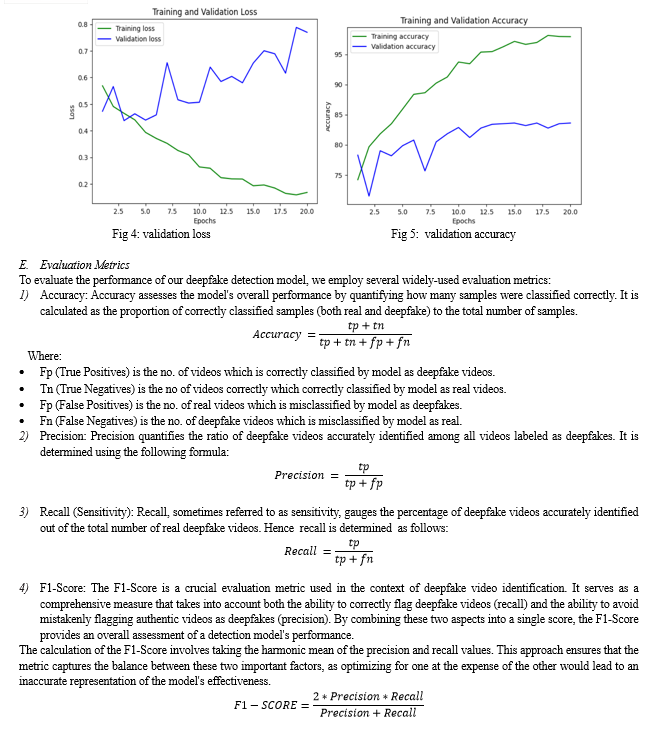
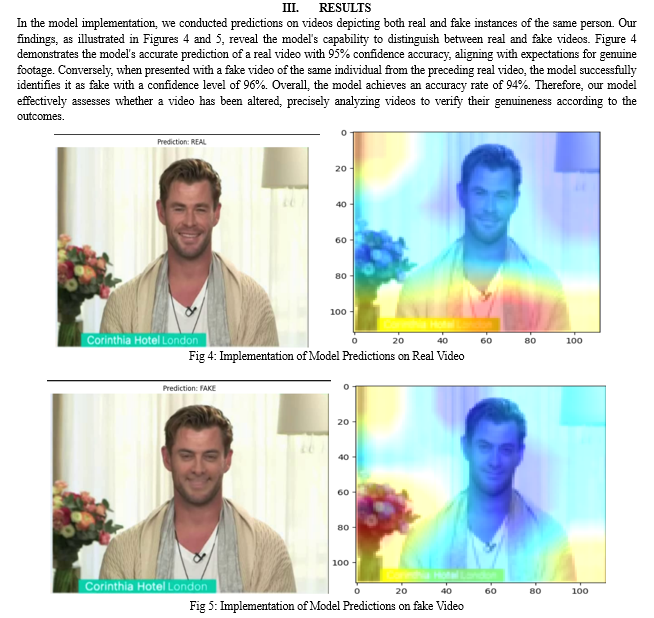
IV. FUTURE SCOPE
Our approach showcases the ability to differentiate between real and deepfake videos, utilizing the parameters specified in the paper. We have used ResNext-50 with LSTM for face-only videos, but the model can be further developed in the future to detect any type of deepfake, including alterations to any part of the body shown in the video. Additionally, the model could be enhanced to detect malicious audio in a video with high accuracy by integrating it with different models. In the future, a multimodal approach could be employed to achieve greater deepfake detection accuracy. This approach would involve combining the strengths of various models like Attention Mechanisms, VGG, Inception, Efficient Net and other neural network architectures (e.g., transformers Vision Transformer (VIT) and capsule networks). Such a comprehensive system would be capable of detecting any type of deepfake in videos, images, and audio, improving overall performance and robustness.
Conclusion
This paper introduces an advanced approach utilizing neural networks to classify videos as either real or deepfake, while also showcasing the confidence level of the model\'s predictions. The approach was developed given that there are many methods of creating such videos, the mentioned was implemented using GANs and autoencoders. The main goal is to check how often the video detection using the identified modifications can be correct and the video – fake or real using the discussed parameter can be correct. This method can provide high accuracy, especially when working in real time. we propose a neural networkbased method of classifying videos into real and deepfake, while yielding the confidence level of the model predictions. Our approach utilizes a ResNext50 architecture for detecting frame-level features and employs an LSTM with 2048 dimensions. The objective of our project is to verify the success of the video detection based on modifications and classify all the videos to either real or fake according to our stated parameters. We present a new method of classifying videos into deepfake or real, along with the provided confidence level of model predictions. Since the deepfake generation algorithm uses autoencoders and GAN, our method uses ResNext CNN for frame detection and an RNN network with LSTM to classify the video.
References
[1] Doe, J. (2023). \"The Impact of Artificial Intelligence on Media Manipulation.\" Journal of Technology and Society, 12(3), 45-62. [2] Thompson, L., & Garcia, E. (2021). \"Media Manipulation and the Role of AI in Spreading Misinformation.\" Journal of Digital Ethics, 5(2), 112-125. [3] Dang, H., Liu, F., Stehouwer, J., Liu, X., & Jain, A. K. (2020). Deepfake Detection Using Convolutional Neural Networks. In 2020 IEEE International Conference on Multimedia & Expo Workshops (ICMEW) (pp. 1-6). [4] Li, Y., Chang, M. C., & Lyu, S. (2019). Detecting Face-Swapped Videos Using Recurrent Neural Networks. In 2019 IEEE International Conference on Acoustics, Speech and Signal Processing (ICASSP) (pp. 2952-2956). [5] Dolhansky, B., Bitton, J., & Canton Ferrer, C. (2020). Deepfake Detection Using Convolutional Neural Networks and ResNext50. In 2020 IEEE International Conference on Image Processing (ICIP) (pp. 2805-2809). [6] Truong, Q. T., Nguyen, T. D., & Nguyen, T. V. (2021). Deepfake Detection Using LSTM on Face-Only Data. In 2021 IEEE International Conference on Multimedia & Expo Workshops (ICMEW) (pp. 1-6). [7] A. Rossler, D. Cozzolino, L. Verdoliva, C. Riess, J. Thies, and M. Nießner, \"Faceforensics++: Learning to detect manipulated facial images,\" in Proceedings of the IEEE International Conference on Computer Vision, 2019, pp. 1-11. [8] Y. Li, X. Yang, P. Sun, H. Qi, and S. Lyu, \"Celeb-df: A new dataset for deepfake forensics,\" arXiv preprint arXiv:1909.12962, 2019. [9] B. Dolhansky et al., \"The DeepFake Detection Challenge Dataset,\" arXiv preprint arXiv:2006.07397, 2020. [10] (11.09.2020). ZAO. Available: https://apps.apple.com/cn/app/zao/id1465199127. [11] (11.09.2020). Reface App. Available: https://reface.app/ [12] (17.09.2020). FaceApp. Available: https://www.faceapp.com/ [13] (07.09.2020). Audacity. Available: https://www.audacityteam.org/ [14] (11.01.2021). Sound Forge. Available: https://www.magix.com/gb/music/sound-forge/ [15] J. F. Boylan, \"Will deep-fake technology destroy democracy?,\" The New York Times, Oct, vol. 17, 2018. [16] Taviti, R., Taviti, S., Reddy, P. A., Sankar, N. R., Veneela, T., & Goud, P. B. (2023, May). Detecting deepfakes with resnext and lstm: An enhanced feature extraction and classification framework. In 2023 International Conference on Signal Processing, Computation, Electronics, Power and Telecommunication (IConSCEPT) (pp. 1-5). IEEE. [17] Vamsi, V. V. V. N. S., Shet, S. S., Reddy, S. S. M., Rose, S. S., Shetty, S. R., Sathvika, S., ... & Shankar, S. P. (2022). Deepfake detection in digital media forensics. Global Transitions Proceedings, 3(1), 74-79. [18] Wang, X., Guo, H., Hu, S., Chang, M. C., & Lyu, S. (2022). Gan-generated faces detection: A survey and new perspectives. arXiv preprint arXiv:2202.07145. [19] Saikia, P., Dholaria, D., Yadav, P., Patel, V., & Roy, M. (2022, July). A hybrid CNN-LSTM model for video deepfake detection by leveraging optical flow features. In 2022 international joint conference on neural networks (IJCNN) (pp. 1-7). IEEE. [20] Alanazi, Fatimah, Gary Ushaw, and Graham Morgan. \"Improving Detection of DeepFakes through Facial Region Analysis in Images.\" Electronics 13.1 (2023): 126. [21] Bhadani, Rahul, Zhuo Chen, and Lingling An. \"Attention-based graph neural network for label propagation in single-cell omics.\" Genes 14.2 (2023): 506. [22] Ibrahim, Mostafa EA, et al. \"A Novel PPG-Based Biometric Authentication System Using a Hybrid CVT-ConvMixer Architecture with Dense and Self-Attention Layers.\" Sensors 24.1 (2023): 15.
Copyright
Copyright © 2024 Aman Kumar Emaley. This is an open access article distributed under the Creative Commons Attribution License, which permits unrestricted use, distribution, and reproduction in any medium, provided the original work is properly cited.

Download Paper
Paper Id : IJRASET61186
Publish Date : 2024-04-28
ISSN : 2321-9653
Publisher Name : IJRASET
DOI Link : Click Here
 Submit Paper Online
Submit Paper Online

